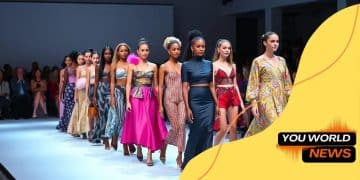The influence of social media on fashion trends

The influence of social media on fashion trends is profound, allowing brands to engage directly with consumers, promote sustainability, and enhance personalization through user-generated content and influencer collaborations.
The influence of social media on fashion trends is undeniable. Ever wondered how a simple post can create a viral sensation? In today’s digital age, platforms like Instagram and TikTok shape our style choices and perceptions of fashion.
How social media reshaped fashion marketing
Social media has fundamentally reshaped fashion marketing in ways we never imagined. Today, brands leverage platforms like Instagram to connect directly with consumers, changing how they promote their products.
In this digital age, engagement is key. Social media allows brands to interact with their audience in real-time, fostering a community around their products. The use of visuals and storytelling is essential, as they draw attention and create a memorable identity.
The Impact of Visual Content
Visuals play a crucial role in fashion marketing. When consumers see stunning images or videos, they are more inclined to make purchases. This leads to brand awareness and loyalty as fashion trends quickly spread online.
Micro-Influencers’ Rise
Micro-influencers have become key players in fashion marketing. With smaller, but more engaged followings, they can create authentic connections with their audiences. This authenticity is something big brands often lack, giving micro-influencers an edge in promoting products.
As brands collaborate with these influencers, they can reach niche markets effectively. This strategy often translates to higher conversion rates compared to traditional advertising.
The Shift Towards User-Generated Content
User-generated content (UGC) also plays an important role in modern marketing strategies. Brands encourage their customers to share photos wearing their products, creating a sense of community and trust. This kind of organic marketing is not only cost-effective but also fosters brand loyalty.
The ability to engage directly with customers through feedback and comments also enhances the personalization of marketing efforts. This responsiveness is something previous marketing strategies couldn’t achieve, making social media an essential tool for fashion brands today.
The role of influencers in setting trends
Influencers play a crucial role in shaping fashion trends today. These individuals have a unique ability to connect with audiences and inspire them through their personal style and creativity. Their influence extends far beyond traditional advertising, making them powerful figures in the fashion industry.
Many fashion brands collaborate with influencers to showcase their latest collections. This partnership not only promotes products but also gives brands a relatable image. When consumers see their favorite influencer wearing a specific outfit, they are more likely to want to purchase it.
Why Influencers Matter
Influencers drive engagement among consumers by sharing authentic content. Their posts often include styling tips, behind-the-scenes looks, and personal stories that resonate with their followers. This authenticity helps brands to build trust and loyalty.
The Power of Social Proof
One important aspect of influencer marketing is the concept of social proof. When potential customers see others enjoying and engaging with a product, they are more inclined to make a purchase themselves. Influencers act as taste-makers, signaling what is trendy and desirable.
This trend-setting ability often creates a ripple effect within fashion. As influencers promote specific styles, these looks begin to appear throughout social media, influencing a larger audience and even mainstream fashion.
Moreover, the diversity among influencers allows for a wide range of styles and audiences. From high fashion to streetwear, influencers can reach different demographics and introduce various fashion elements to their followers.
User-generated content and its impact on fashion

User-generated content (UGC) has become a major force in the fashion industry. This type of content allows brands to engage directly with their consumers, creating a sense of community and connection. By encouraging customers to share their personal style, brands can showcase real people using their products.
UGC provides authenticity that traditional marketing often lacks. When potential buyers see real customers in clothes they admire, it influences their decisions. This relational marketing makes the shopping experience more personal and relatable.
The Role of Social Media
Social media platforms are crucial for the success of user-generated content. Users post photos and videos of themselves wearing various fashion items, often tagging the brands. This not only expands the brand’s reach but also fosters a deeper connection with the audience.
Building Brand Loyalty
As customers actively participate in sharing their experiences, they develop a sense of loyalty to the brand. This loyalty can lead to repeat purchases and increased word-of-mouth marketing. When customers feel valued, they are more likely to refer their friends and family.
The impact of UGC doesn’t stop there. Brands can curate this content to create marketing campaigns that resonate more with their audience. For instance, using customer photos in ads adds a layer of respect and recognition to the marketing strategy.
Also, showcasing customers rather than models helps in appealing to a wider audience. Many consumers appreciate seeing themselves reflected in the marketing, which further strengthens their connection to the brand.
Emerging platforms changing the fashion landscape
Emerging platforms are revolutionizing the fashion landscape, creating new opportunities for brands and consumers alike. As technology evolves, we see a shift in how fashion is marketed and consumed. These platforms are reshaping the way we discover and engage with fashion trends.
New applications and social media outlets are making it easier than ever for users to interact with their favorite brands. Many platforms now focus on visual content, allowing users to share outfits and styling tips in real time. This dynamic interaction encourages creativity and engagement among users.
Short-Form Video Content
Apps like TikTok have introduced short-form video content as a powerful marketing tool for fashion brands. Users can create fun and engaging videos showcasing how they style different pieces, which often goes viral. This type of content is not only entertaining but also informative, helping consumers see how to wear outfits in everyday life.
Online Marketplaces and Selling Platforms
Emerging online marketplaces have also changed how fashion is sold. Platforms like Depop and Poshmark allow users to buy and sell second-hand and vintage items easily. This not only supports sustainability but also gives consumers a chance to find unique pieces that reflect their personal style.
These platforms enable individuals to act as both consumers and sellers, blurring the lines between shopping and socializing. As a result, they create a community where fashion lovers can connect, share ideas, and inspire one another.
Moreover, the increasing popularity of augmented reality (AR) shopping experiences offers a unique twist. Consumers can see how clothes fit and look before they buy them, reducing the likelihood of returns. This technology enhances online shopping and provides confidence to customers, leading to more purchases.
The future of fashion in the age of social media
The future of fashion in the age of social media looks bright and dynamic. Social media continues to change how brands connect with consumers, making it essential for trends to emerge rapidly. As technology evolves, so does the way fashion is presented and perceived.
With platforms like Instagram, TikTok, and Pinterest, fashion brands reach audiences instantly. Visual content is more influential than ever. Trends spread through hashtag challenges and viral videos, creating new styles almost overnight. This fast-paced environment means that brands must stay agile to remain relevant.
Increased Personalization
Another aspect of the future of fashion is the rise of personalization. Consumers want unique experiences tailored to their preferences. Brands are now using data analytics to understand customer behavior better.
Sustainability and Ethical Fashion
Moreover, social media is amplifying the call for sustainability. Consumers are increasingly concerned about their choices, pushing brands to adopt more eco-friendly practices. They want to know where their clothes come from and how they affect the planet. Brands that prioritize sustainability will thrive.
Brands are also using their platforms to promote ethical fashion and transparency. Not only can they market their sustainable practices, but they can also educate consumers about the impact of fast fashion.
In conclusion, as social media becomes more integrated into our daily lives, the fashion industry will continue to evolve. Brands must stay innovative, prioritizing personalization and sustainability to meet the demands of the modern consumer.
FAQ – Frequently Asked Questions about Fashion in the Age of Social Media
How has social media changed the fashion industry?
Social media allows brands to connect with consumers instantly, making it easier to promote new trends and engage with audiences.
What role do influencers play in fashion?
Influencers help set trends and inspire followers by showcasing their personal styles, creating authentic connections with their audiences.
Why is user-generated content important?
User-generated content provides authenticity, as real customers show how they style products, which builds trust and encourages others to purchase.
What is the focus on sustainability in fashion?
Consumers are increasingly demanding eco-friendly practices, pushing brands to adopt sustainable solutions and promote transparency in their production processes.





